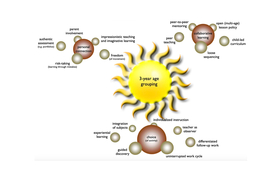
Practical Life activities in a Montessori classroom assist the child to control and coordinate their moments, and one of the earliest activities introduced in a 3-6 classroom is called “Walking on the Line”. Montessori saw this as a natural extension of something children liked to do (walking on curbs or tracks) and developed the activity not only to help them control their body, develop balance and perfect equilibrium, but to strengthen the mind’s control of its body’s movements.
The exercise should be undertaken on a slim line in an elliptical pattern, which attracts interest and challenge. It is often done at the beginning of the school year with the whole group of children, and then in smaller sub-groups, increasing the difficulty. The children are first invited to walk along the line, keeping equidistant from each other as a light, soft background music (such as a classical piece) is played. Ideally done without shoes, the children are also told that they are free to walk on the line whenever they like.
The next stage is to have them walk heel to toe, again keeping equidistant as they go. The exercise is a walking meditation, with the interest stemming from ensuring that the child has the right level of difficulty. This difficulty is ramped up to add objects for them to carry during the walk. From carrying a bell without making it ring, to carrying a bowl of water without spilling it, up to balancing a book or basket on their heads, or a combination of any of these.
“When a child is master of his feet in walking, his attention can be distributed on different movements. Thus, the child can carry a glass of water and hold it in such a way that the water does not spill because if he does not pay attention to the glass, while he watches his feet, the water spills. Then his attention, little by little is carried to all his body, to keeping his feet straight on the line and to holding the glass straight and he becomes conscious of his whole body.” (Montessori, Maria, The California Lectures of Maria Montessori, Collected Speeches and Writings, 1915, Oxford, England, Clio Press, p. 217-218)



